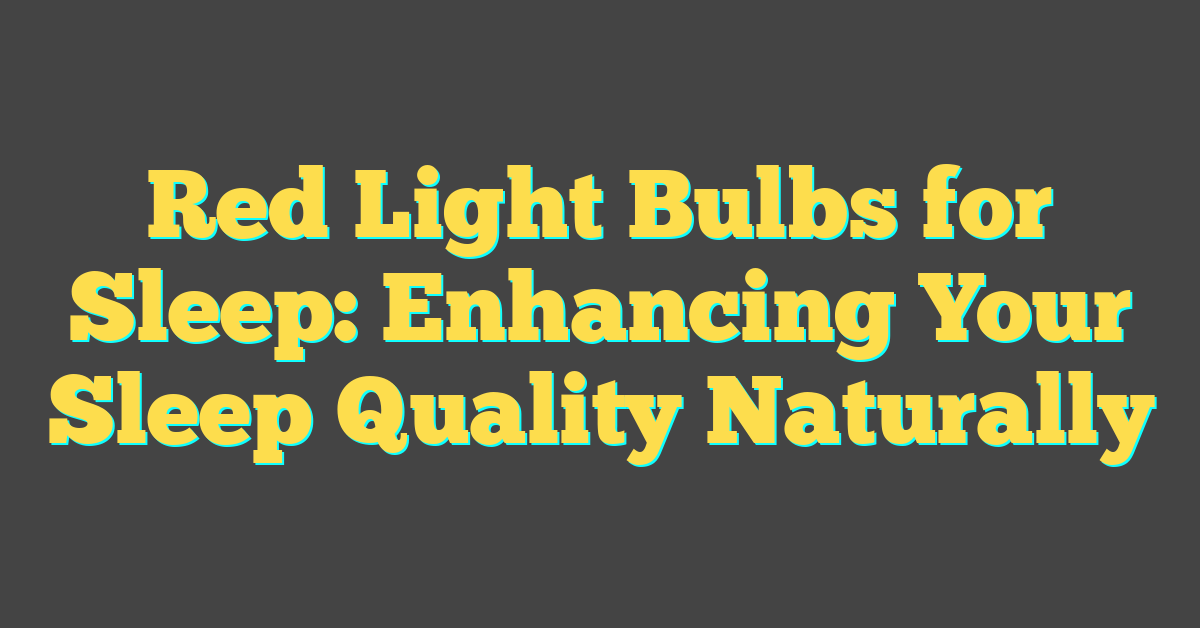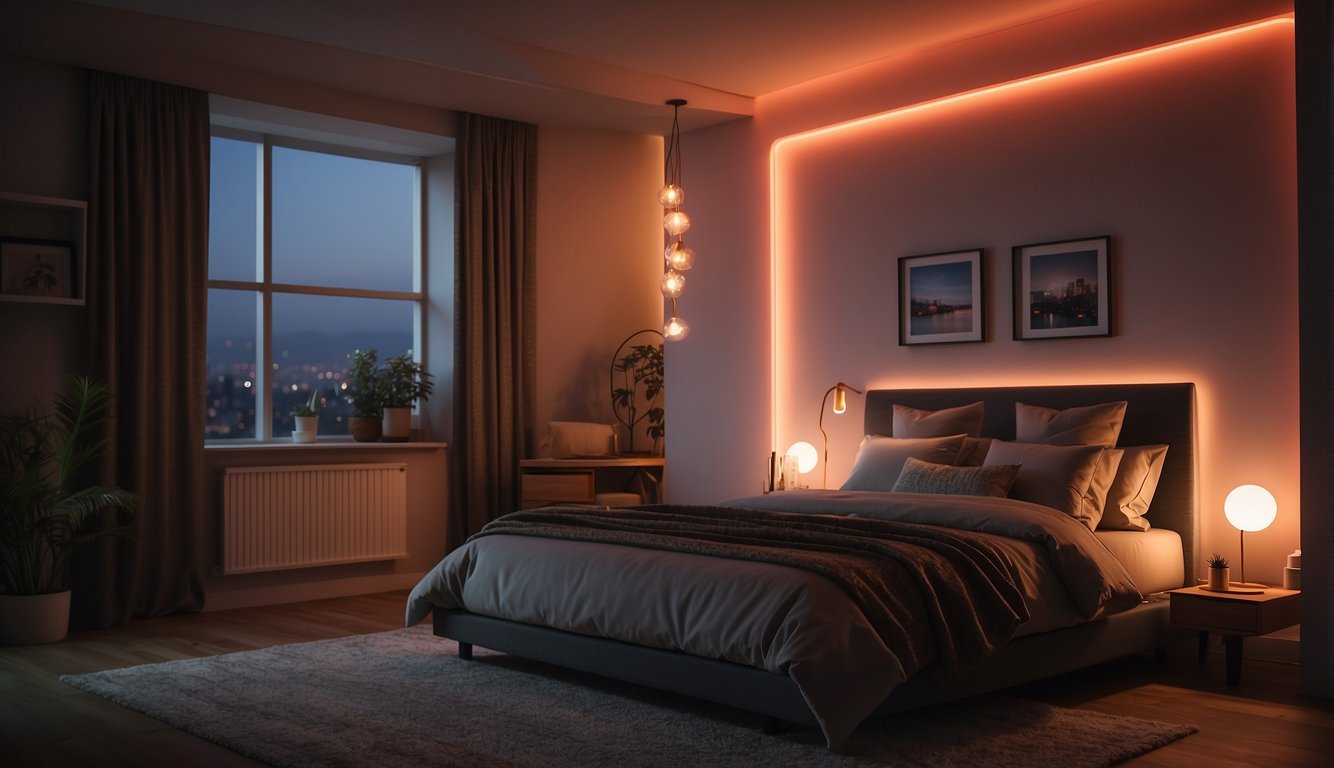Exploring the potential benefits of red light bulbs for sleep has garnered increasing interest as people seek ways to improve their sleep quality. Exposure to different types of light during the evening can have varying effects on your body’s ability to fall asleep. Research has indicated that red light might have a less disruptive impact on our sleep patterns than other wavelengths, especially the blue light emitted from many electronic devices. Understanding the interaction between light exposure and sleep can lead to more informed choices about the lighting used in your sleeping environment.


Red light seems advantageous as it has a lower color temperature compared to blue light, which is often linked to sleep disturbances. By replacing bright, blue light-emitting bulbs with red light bulbs, you might find it easier to wind down at night. This is because red light has been suggested to support the natural production of melatonin, the hormone that signals your brain it’s time to sleep. Implementing red light bulbs at home could be a simple step toward enhancing your sleep quality, and thereby, contributing to better overall health.
Key Takeaways
- Red light exposure is less likely to disrupt sleep than blue or green light.
- Red light bulbs may help in the production of sleep-inducing melatonin.
- Using red light at night can contribute to better sleep and health.
The Science of Sleep and Light Exposure
https://www.youtube.com/watch?v=gbQFSMayJxk&embed=true
Your body’s sleep-wake cycle is significantly influenced by light, which can enhance or disrupt your sleep quality. Melatonin, the sleep hormone, plays a key role in this process.
Effects of Light on Sleep Quality
Light exposure directly affects the quality of your sleep. At night, darkness prompts your body to produce melatonin, signaling that it’s time to sleep. Bright light, especially blue light from electronic devices, can suppress melatonin secretion and shift your sleep cycle, making it harder for you to fall asleep. On the other hand, light exposure during the day, particularly from light therapy, is beneficial as it can strengthen your circadian rhythm and improve night-time sleep quality.
Understanding Circadian Rhythms
Your circadian rhythm is your body’s internal clock that dictates your natural sleep and wake cycles. It responds primarily to light in your environment—natural sunlight during the day helps keep your circadian rhythm healthy. However, not all light is equal: red light at night has less impact on your sleep cycle compared to blue or green light. That’s why limiting exposure to bright screens before bed and considering a red light source can help maintain your natural sleep patterns.
Benefits of Red Light Bulbs for Sleep
https://www.youtube.com/watch?v=UU9gAnh3x7g&embed=true
Using red light bulbs may assist you in achieving a more restful night’s sleep. Specifically, they can help enhance your body’s melatonin production and minimize certain sleep disorders.
Enhancing Melatonin Production
Melatonin is a hormone that your body naturally produces in response to darkness, signaling it’s time to sleep. Red light bulbs can support your melatonin production because they emit a wavelength that’s less disruptive at night than blue light. A study showed that red light could be beneficial in maintaining your natural sleep cycle without suppressing the sleep-inducing hormone melatonin.
- Key Fact: Unlike blue light, red light doesn’t inhibit melatonin.
Minimizing Sleep Disorders
If you’re struggling with sleep disorders such as insomnia, red light bulbs might offer relief. The warm hues of red light are associated with a decrease in sleep challenges. By using red light therapy for sleep, some individuals find improved sleep quality and a reduction in the time it takes to fall asleep.
- Benefit: Red light can potentially diminish the symptoms of several sleep-related disorders, contributing to better overall health.
Red vs. Blue and Green Light

When you’re considering the impact of light on your sleep, it’s important to understand how different colors of light—red, blue, and green—affect your circadian rhythms.
Comparing Light Spectrums
Blue Light: Often emitted by screens and some light bulbs, blue light has a short wavelength, which makes it highly energetic. Exposure to blue light, particularly during evening hours, can disrupt your natural sleep-wake cycle, making it harder for you to fall asleep.
Red Light: Comparatively, red light has a longer wavelength and is less intense. Using red light bulbs for healthy sleep can be beneficial as they’re known to have minimal impact on your sleep patterns, potentially making it easier for you to fall asleep.
« Free Energy Saving Light Bulbs: Brighten Your Home Sustainably
Different Light Bulb Bases: Your Guide to the Right Fit »
Green Light: Green light also has a shorter wavelength, but it’s not as disruptive as blue light. However, it can still affect sleep more than red light, so it’s not your best choice when winding down for the night.
Impact of Colors on Sleep Cycle
Blue and Green Light: These colors can suppress the production of melatonin, which is the hormone that helps you feel sleepy. Your circadian rhythm—your body’s natural 24-hour clock—can become disrupted, leading to challenges in initiating and maintaining sleep.
Red Light: Less intrusive on your circadian rhythm, red light’s influence on your sleep cycle is much milder. It doesn’t suppress melatonin production as much, which is why red light is often recommended in the hours leading up to bedtime. If you’re looking to create an environment conducive to sleep, opting for light that supports your sleep might be beneficial.
You can adjust your evening lighting to better cater to your sleep cycles by incorporating the right colors of light. Choosing red light for evening time can help maintain the natural rhythm of your body, encouraging a better night’s sleep.
Choosing the Right Red Light Bulbs
https://www.youtube.com/watch?v=IlJAvLaqK5E&embed=true
When selecting red light bulbs for sleep improvement, it’s important to consider the color temperature and bulb type. The right bulb can create a calming bedroom ambiance, conducive to rest.
Understanding Color Temperature
Color temperature is measured in Kelvin (K) and describes how “warm” or “cool” a light appears. For sleep, you want a low color temperature that emulates the warm glow of sunset. Red light bulbs typically have a low color temperature, which doesn’t interfere with your sleep cycle as blue light does. Aim for red light bulbs around 1,500K to create a soothing, sleep-friendly environment.
LED Bulbs vs. Incandescent Bulbs
LED bulbs are energy-efficient and have a longer lifespan than incandescent bulbs. They are often recommended for their low heat emission and ability to provide the same red tones with less power consumption. However, incandescent bulbs have a naturally lower color temperature, which can make them a good choice for ambient lighting in the bedroom. Remember to check the brightness, as you’ll want less-lit surroundings before bedtime. Here’s a quick comparison:
| Bulb Type | Energy Efficiency | Lifespan | Heat Emission |
|---|---|---|---|
| LED Bulbs | High | Long (up to 25x) | Low |
| Incandescent Bulbs | Lower | Shorter | Higher |
Choose LED red light bulbs if you prioritize energy savings and longevity. Opt for incandescent bulbs if you prefer a traditional glow and aren’t concerned about changing bulbs more frequently.
Implementing Red Light Therapy at Home
https://www.youtube.com/watch?v=XHZNCnKbNnY&embed=true
Red light therapy can be a soothing addition to your nightly routine, potentially enhancing your sleep quality. With the right setup and usage, your bedroom can turn into a haven for restful slumber.
Tips for Setup
- Choosing the Right Bulb: Look for bulbs specifically labeled for red light therapy to ensure an appropriate wavelength for sleep enhancement.
- Placement: Install your red light therapy device in an area where you’ll be exposed to the light as you wind down before bed—by your bedside, for instance.
To achieve the best results from red light therapy, it’s important to establish consistent exposure as it may help regulate your melatonin production and circadian rhythms. Devices range from lamps to masks and can be matched to your preferences for convenience and comfort.
Maximizing Therapy Benefits
- Timing Your Sessions: Aim for a 15- to 30-minute session before your bedtime. Regular use can contribute to a healthier sleep cycle.
- Minimize Other Light Sources: Dim or turn off other lights to allow the red light to be the dominant source, which may aid melatonin regulation and signal your body to prepare for sleep.
Light exposure, particularly from red light therapy devices, could be a supportive element for your health by possibly improving sleep. Ensure that you’re comfortable and relaxed during your therapy sessions for optimal benefits.
Avoiding Sleep Inertia with Red Light
https://www.youtube.com/watch?v=Rh8MyP67q34&embed=true
Good morning! You’re about to discover how red light bulbs can be a game changer for your mornings. The key takeaways are understanding sleep inertia and how specific lighting can help you transition to alertness more comfortably.
What is Sleep Inertia?
Sleep inertia is that groggy feeling you get immediately after waking up. It’s like a heavy blanket of drowsiness that makes it tough to get out of bed. Your brain is in a state of transition, and during this period, your performance and alertness can be significantly impaired.
Role of Light Bulbs in Morning Alertness
Believe it or not, the color of light in your bedroom when you wake up can influence how quickly you shake off sleep inertia. Red light bulbs emit a warm hue that does not suppress melatonin, the sleep hormone, as much as other lights do. Exposure to red light in the morning may help in reducing sleep inertia and boosting your alertness without the harsh effects that white or blue light can impose on your sleepy self. This is particularly helpful since your body’s exposure to light helps regulate your natural sleep and wake cycle.
Red Light and Electronics

In the world of sleep science, the colors emitted by your electronic screens and the bulbs you choose for your night lights can have a significant impact on your sleep quality.
Effects of Screens on Sleep
Electronic screens such as smartphones, laptops, and televisions emit blue light, which can interfere with your natural sleep cycle. Blue light exposure at night, especially from electronic devices, may suppress the secretion of melatonin, a hormone responsible for regulating sleep and wakefulness. This suppression can lead to difficulties in falling asleep or poor sleep quality.
To mitigate the effects, consider using settings or applications that adjust the color temperature of your screens to emit warmer tones in the evenings. Some electronic devices are equipped with modes that reduce blue light, which you can enable during nighttime hours.
Choosing Night Lights and Bulbs
For a sleep-friendly environment, the color of your night lights and light bulbs is crucial. Red lights are a good choice for a night light because they have a much lower impact on disrupting the body’s circadian rhythm compared to blue or white lights. When selecting light bulbs for your bedroom or electronic devices for night use, opt for those that simulate sunset hues, such as red or orange, which can create a calming atmosphere and support melatonin production.
To create an optimal sleep environment, consider replacing standard light bulbs with red light bulbs designed for sleep, and avoid the use of bright, blue-light emitting electronic screens closer to bedtime.
Mitigating Jet Lag and Shift Work Disorder
https://www.youtube.com/watch?v=NAATB55oxeQ&embed=true
When dealing with jet lag and shift work disorder, the timing and color of your light exposure are crucial in resetting your circadian rhythm. Red light, in particular, is considered beneficial for managing these sleep disruptions.
Using Red Light Strategically
To address jet lag or shift work disorder, incorporating red light bulbs can aid in your sleep health. Red light is thought to have less potential to shift your circadian rhythm compared to blue light, making it a suitable choice for evening activities. It helps prepare your body for sleep by signaling that it is nighttime, which is essential for aligning with the local time after traveling across time zones. You might consider red light bulbs in your bedroom or other areas where you unwind before bed.
Timing Light Exposure
Managing your exposure to light is pivotal for healthy sleep and mitigating circadian-related disorders. Here’s a straightforward approach:
- Morning: Seek bright, preferably natural light to help wake up your body.
- Evening: Starting 2-3 hours before bedtime, limit exposure to bright light, especially blue light.
- Bedtime: Utilize red light as part of your light therapy routine by using red light bulbs. This type of light is less likely to interfere with your sleep.
Exposure to red light in the evening can assist in regulating your circadian rhythm and improving the quality of your sleep, particularly if you’re managing irregular work schedules or frequently traveling across multiple time zones.
Red Light Bulbs and Mood Regulation
https://www.youtube.com/watch?v=RTIRwJR-9HQ&embed=true
You might be surprised to learn that the light bulbs you choose can affect more than just your ability to see in the dark. Specifically, red light bulbs have been linked to potential benefits in mood regulation and overall health.
Psychological Effects of Light
The light that surrounds you has a profound impact on your psychological well-being. It turns out that red light has a unique influence on your body. Exposure to red light at night contrasts significantly with blue light, commonly emitted by screens and LEDs, which can disrupt your sleep cycle. Red light, however, seems to have a milder effect on your sleep-wake rhythm, making it easier for you to wind down and prepare for rest. This connection suggests that using red light bulbs in your evening environment may support your natural circadian rhythm, thus fostering a more settled and positive mood.
Improving Mood and Metabolism
Switching to red light in the evenings can do more than just get you ready for sleep; it can also play a role in the regulation of your metabolism. When your body winds down properly, your metabolism gets a chance to work effectively, engaging in restorative processes that impact your health and mood. By enhancing your sleep quality with red light bulbs, you could be supporting more than just solid rest; you’re potentially improving your body’s nightly rejuvenation which boosts your mood and metabolic function. This subtle yet significant change in your light environment might just be a beneficial tweak to your night-time routine.
Energy Efficiency and Environmental Impact

When you’re considering red light bulbs for sleep, it’s important to understand their energy efficiency and environmental impact. How they’re made and how they consume energy can affect both your utility bills and the planet.
LEDs vs. Conventional Light Bulbs
LED bulbs are significantly more energy efficient compared to conventional incandescent bulbs. Specifically, LED bulbs use about 75% less energy than incandescent lighting. Furthermore, when you opt for red LED bulbs, you’re not only using less energy, you’re also getting the sleep benefits without the high energy cost associated with non-LED alternatives. Plus, LED bulbs last much longer – often up to 25 times longer – than traditional light bulbs. This means you’ll be purchasing and disposing of fewer bulbs over time, which is better for the environment.
Sustainable Light Solutions
Opting for LED red lights is a more sustainable light solution. Their longer lifespan means reduced waste creation and fewer resources needed for manufacturing, packaging, and transportation. If you’re looking to make your home more eco-friendly, consider the fact that LED bulbs can be recycled, whereas many conventional lightbulbs cannot. This sustainable choice diminishes your carbon footprint and can also lead to lower waste disposal costs in your local community. By choosing LEDs, you’re contributing to a decrease in demand for energy from power plants, which then helps to reduce greenhouse gas emissions.




